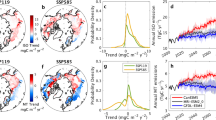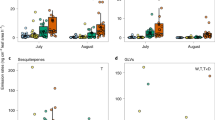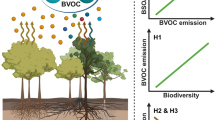Abstract
Biogenic volatile organic compounds are reactive gases that can contribute to atmospheric aerosol formation1. Their emission from vegetation is dependent on temperature and light availability2. Increasing temperature, changing cloud cover and shifting composition of vegetation communities can be expected to affect emissions in the Arctic, where the ongoing climate changes are particularly severe3. Here we present biogenic volatile organic compound emission data from Arctic tundra exposed to six years of experimental warming or reduced sunlight treatment in a randomized block design. By separately assessing the emission response of the whole ecosystem, plant shoots and soil in four measurements covering the growing season, we have identified that warming increased the emissions directly rather than via a change in the plant biomass and species composition. Warming caused a 260% increase in total emission rate for the ecosystem and a 90% increase in emission rates for plants, while having no effect on soil emissions. Compared to the control, reduced sunlight decreased emissions by 69% for the ecosystem, 61–65% for plants and 78% for soil. The detected strong emission response is considerably higher than observed at more southern latitudes, emphasizing the high temperature sensitivity of ecosystem processes in the changing Arctic.
This is a preview of subscription content, access via your institution
Access options
Subscribe to this journal
Receive 12 print issues and online access
$259.00 per year
only $21.58 per issue
Buy this article
- Purchase on Springer Link
- Instant access to full article PDF
Prices may be subject to local taxes which are calculated during checkout



Similar content being viewed by others
References
Paasonen, P. et al. Warming-induced increase in aerosol number concentration likely to moderate climate change. Nature Geosci. 6, 438–442 (2013).
Laothawornkitkul, J., Taylor, J. E., Paul, N. D. & Hewitt, C. N. Biogenic volatile organic compounds in the Earth system. New Phytol. 183, 27–51 (2009).
IPCC Climate Change 2013: The Physical Science Basis (eds Stocker, T. F. et al.) (Cambridge Univ. Press, 2013); http://www.climatechange2013.org
Smith, S. J., Edmonds, J., Hartin, C. A., Mundra, A. & Calvin, K. Near-term acceleration in the rate of temperature change. Nature Clim. Change 5, 333–336 (2015).
Carslaw, K. S. et al. Atmospheric aerosols in the Earth system: a review of interactions and feedbacks. Atmos. Chem. Phys. 9, 11087–11183 (2009).
Guenther, A. B. et al. The Model of Emissions of Gases and Aerosols from Nature version 2.1 (MEGAN2.1): an extended and updated framework for modeling biogenic emissions. Geosci. Model Dev. 5, 1471–1492 (2012).
Grote, R. & Niinemets, Ü. Modeling volatile isoprenoid emissions—A story with split ends. Plant Biol. 10, 8–28 (2008).
Holst, T. et al. BVOC ecosystem flux measurements at a high latitude wetland site. Atmos. Chem. Phys. 10, 1617–1634 (2010).
Potosnak, M. J. et al. Isoprene emissions from a tundra ecosystem. Biogeosciences 10, 871–889 (2013).
Rinnan, R., Steinke, M., McGenity, T. & Loreto, F. Plant volatiles in extreme terrestrial and marine environments. Plant Cell Environ. 37, 1776–1789 (2014).
Körner, C. in Plant Growth and Climate Change (eds Morison, J. I. L. & Morecroft, M.) 48–69 (Blackwell, 2007).
Niinemets, Ü., Loreto, F. & Reichstein, M. Physiological and physicochemical controls on foliar volatile organic compound emissions. Trends Plant Sci. 9, 180–186 (2004).
Valolahti, H., Kivimäenpää, M., Faubert, P., Michelsen, A. & Rinnan, R. Climate change-induced vegetation change as a driver of increased subarctic biogenic volatile organic compound emissions. Glob. Change Biol. 21, 3478–3488 (2015).
Faubert, P. et al. Doubled volatile organic compound emissions from subarctic tundra under simulated climate warming. New Phytol. 187, 199–208 (2010).
Monson, R. K. et al. Isoprene emission from terrestrial ecosystems in response to global change: minding the gap between models and observations. Phil. Trans. R. Soc. A 365, 1677–1695 (2007).
Peñuelas, J. & Staudt, M. BVOCs and global change. Trends Plant Sci. 15, 133–144 (2010).
Elmendorf, S. C. et al. Plot-scale evidence of tundra vegetation change and links to recent summer warming. Nature Clim. Change 2, 453–457 (2012).
Elmendorf, S. C. et al. Global assessment of experimental climate warming on tundra vegetation: heterogeneity over space and time. Ecol. Lett. 15, 164–175 (2012).
Snow, Water, Ice and Permafrost in the Arctic (SWIPA): Climate Change and the Cryosphere (Arctic Monitoring and Assessment Programme, 2011); http://www.amap.no/documents/doc/snow-water-ice-and-permafrost-in-the-arctic-swipa-climate-change-and-the-cryosphere/743
Niinemets, Ü. in Advances in Plant Physiology (ed. Hemantaranjan, A.) 233–268 (Scientific Publishers, 2004).
Guenther, A. B., Zimmerman, P. R., Harley, P. C., Monson, R. K. & Fall, R. Isoprene and monoterpene emission rate variability: model evaluations and sensitivity analyses. J. Geophys. Res. 98, 12609–12617 (1993).
Tiiva, P. et al. Climatic warming increases isoprene emission from a subarctic heath. New Phytol. 180, 853–863 (2008).
Le Roux, P. C., Aalto, J. & Luoto, M. Soil moisture’s underestimated role in climate change impact modelling in low-energy systems. Glob. Change Biol. 19, 2965–2975 (2013).
Dani, S., Jamie, I. M., Prentice, I. C. & Atwell, B. J. Increased ratio of electron transport to net assimilation rate supports elevated isoprenoid emission rate in eucalyptus under drought. Plant Physiol. 166, 1059–1072 (2014).
Loreto, F. & Schnitzler, J.-P. Abiotic stresses and induced BVOCs. Trends Plant Sci. 15, 154–166 (2010).
Peñuelas, J. et al. Biogenic volatile emissions from the soil. Plant Cell Environ. 37, 1866–1891 (2014).
Poorter, H. et al. Biomass allocation to leaves, stems and roots: meta-analyses of interspecific variation and environmental control. New Phytol. 193, 30–50 (2012).
Rinnan, R., Michelsen, A., Bååth, E. & Jonasson, S. Fifteen years of climate change manipulations alter soil microbial communities in a subarctic heath ecosystem. Glob. Change Biol. 13, 28–39 (2007).
Geladi, P. & Kowalski, B. R. Partial least-squares regression: a tutorial. Anal. Chim. Acta 185, 1–17 (1986).
Cleveland, C. C. & Yavitt, J. B. Microbial consumption of atmospheric isoprene in soil. Geophys. Res. Lett. 24, 2379–2382 (1997).
Jensen, L. M. & Rasch, M. (eds) NERO—Nuuk Ecological Reseach Operations 1st Annual Report 2007 (Danish Polar Center, Danish Agency for Science, Technology and Innovation, Ministry of Science, Technology and Innovation, 2008); http://nuuk-basic.dk/publications/annual-reports
Tholl, D. et al. Practical approaches to plant volatile analysis. Plant J. 45, 540–560 (2006).
Ortega, J. et al. Approaches for quantifying reactive and low-volatility biogenic organic compound emissions by vegetation enclosure techniques—Part B: Applications. Chemosphere 72, 365–380 (2008).
Jonasson, S. Evaluation of the point intercept method for the estimation of plant biomass. Oikos 52, 101–106 (1988).
Jenkinson, D. S. & Powlson, D. S. The effects of biocidal treatments on metabolism in soil—V. A method for measuring soil biomass. Soil Biol. Biochem. 8, 209–213 (1976).
Wehrens, R., Putter, H., Lutgarde, M. & Buydens, C. The bootstrap: a tutorial. Chemometr. Intell. Lab. 54, 35–52 (2000).
Acknowledgements
We thank M. B. Dahl, P. C. Brusvang and M. S. Haugwitz for sharing excellent and invaluable data sets and G. Schurgers and C. Albers for constructive criticism and useful suggestions for the manuscript. We also thank the Villum Foundation, the Danish Council for Independent Research |Natural Sciences, and the Carlsberg Foundation for funding the project. The Danish National Research Foundation supported the activities within the Center for Permafrost (CENPERM DNRF100). Pinngortitaleriffik—Greenland Institute of Natural Resources and Greenland Ecosystem Monitoring Programme provided an excellent logistical basis for the work. Data from the Greenland Ecosystem Monitoring Programme were provided by the Department of Bioscience, Aarhus University, Denmark in collaboration with Greenland Institute of Natural Resources, Nuuk, Greenland, and Department of Biology, University of Copenhagen, Denmark.
Author information
Authors and Affiliations
Contributions
M.K. and I.V.-P. collected the data. M.K., I.V.-P., M.S. and R.R. analysed and interpreted the data set. Å.R. performed the PLS analysis. J.N. and H.R.-P. established the experimental site. M.K. wrote the manuscript with contributions from all authors.
Corresponding author
Ethics declarations
Competing interests
The authors declare no competing financial interests.
Supplementary information
Supplementary Information
Supplementary Information (PDF 469 kb)
Supplementary Information
Supplementary Information (XLSX 45 kb)
Rights and permissions
About this article
Cite this article
Kramshøj, M., Vedel-Petersen, I., Schollert, M. et al. Large increases in Arctic biogenic volatile emissions are a direct effect of warming. Nature Geosci 9, 349–352 (2016). https://doi.org/10.1038/ngeo2692
Received:
Accepted:
Published:
Issue Date:
DOI: https://doi.org/10.1038/ngeo2692
This article is cited by
-
Exchange of volatile organic compounds between the atmosphere and the soil
Plant and Soil (2024)
-
BVOC Emissions From a Subarctic Ecosystem, as Controlled by Insect Herbivore Pressure and Temperature
Ecosystems (2022)
-
Aerosols in current and future Arctic climate
Nature Climate Change (2021)
-
Amplification of plant volatile defence against insect herbivory in a warming Arctic tundra
Nature Plants (2019)
-
Boreal forest soil is a significant and diverse source of volatile organic compounds
Plant and Soil (2019)



